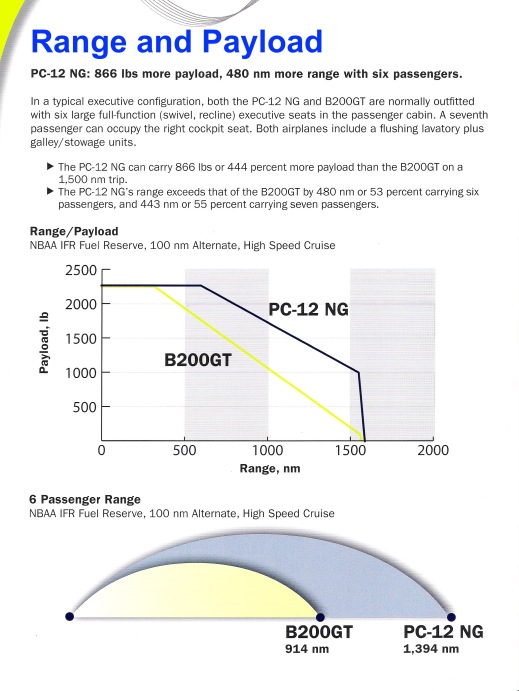 The economy, utility and safety of various aircraft, be they private singles or corporate carriages, are hotly debated subjects on the ramp among pilots and in boardrooms among CFOs. This controversy also fuels the sale of many flying magazines. (See this recent Flying Magazine article). There are a huge number of variables to consider when making a sensible decision and it most often comes down to specific mission requirements or just personal preference. For some owners, money is no object and its “image not numbers.” For them, the question is a simple what you “want” to fly in. You see some crazy big jet/short flight operations at every airport.
The economy, utility and safety of various aircraft, be they private singles or corporate carriages, are hotly debated subjects on the ramp among pilots and in boardrooms among CFOs. This controversy also fuels the sale of many flying magazines. (See this recent Flying Magazine article). There are a huge number of variables to consider when making a sensible decision and it most often comes down to specific mission requirements or just personal preference. For some owners, money is no object and its “image not numbers.” For them, the question is a simple what you “want” to fly in. You see some crazy big jet/short flight operations at every airport.
But for a charter company interested in payload, range, economy and comfort (not to mention safety, utility and versatility) the Pilatus wins most of these discussions hands down for the shorter missions. The Pilatus PC-12, once spartan and utilitarian in their offerings (the utility moving van) has stepped up it’s game with luxurious BMW interiors and sophisticated Honeywell avionics. Consequently, Pilatus is flourishing while Beechcraft is struggling through bankruptcy (always other issues there too). This article will dig into the safety considerations of single vs twins first then compare the most common corporate twin, the Beech King Air, directly to the Pilatus PC-12NG. “Just the facts mam!”


Data for this table was derived from this study.
The early days of aviation often required numerous engines for safety since early engines were remarkably unreliable. This all changed with the amazing PT-6 Pratt and Whitney engine and other similar turboprop engines. The PT-6 rate of in-flight failure is under 1 shut-down per 500,00 hours of operation; a remarkable reliability! OK, so why not increase safety with two PT-6 engines on board like the Beechcraft King Air? Unfortunately, with the safety record with two engines on board, like the Beech King Air, is actually worse than flying a single. How can this be true? Largely because most twin engine aircraft almost *require* both engines to fly at all. When an engine failure occurs, cool thinking and superior piloting skill are a necessity to keep the twin in the air. And the safety consequences of mishandling a failed engine on a twin are much more catastrophic to safety and survival (due to Vmc roll over) than a “fail and glide” single engine scenario. Pilatus spent a lot of research and money “selling the single” and developed the compelling slide share “Sweet to be Single.” This is very well researched and presented and I encourage you to look through their presentation.

In summary though, Richard N. Aarons, a safety analyst put it succinctly summarizing the NTSB data on the FAA safety website: ” An engine failure-related accident in a twin-turboprop is four times more likely to cause serious and fatal injuries.” As the facts about single-engine safety have become known, one big paddle out front ends up safer than the “perceived safety” of a twin. Also the aerodynamically clean Pilatus PC-12 can glide remarkably well providing additional options in the unlikely event of an engine shut-down. From 30,000 ft (service ceiling) a PC-12 can glide 32 minutes and 90 statue miles and is certified to land safely on grass or dirt runways. To prove the remarkable reliability of the PC-12, Pilatus recently sponsored an around the world flight piloted by Amelia Rose Earhart (no relation). This took 18 days, covered 14 countries, and used the 1 remarkable PT-6 engine that had 0 squawks!

It is important to remember however, that when the PC-12 was being developed and introduced, single engine passenger 135 operations were not allowed in the US! Pilatus bet their whole company on the incredible safety record of the Pratt and Whitney PT-6 engine and the evolution of the regulatory environment. The demonstrated safety record of single engine turbo props has led to the FAA approval of single engine (and even single pilot) IFR/VFR charter in the US. Quite an impressive turn-around in policy. The final frontier is the safety perception of the charter flying customers.

In the King Air realm, Wheels Up operates exclusively in King Airs (and now Cessna Excel Jets for longer missions). Their justification for the King Airs here.
In the PC-12 corner is Plane Sense operating an airline and charter exclusively with the PC12s. Their justification for the PC-12 here.
operating an airline and charter exclusively with the PC12s. Their justification for the PC-12 here.
Comparison of a Beechcraft King Air and a Pilatus PC-12:

The PC-12 carries 866 lbs more payload and has 480nm more range with the same six passengers.
The Pilatus is also bigger inside than the King Air and has that incredible four foot wide cargo loading door to make all kinds of items a cinch to bring most anything along. This adds to the versatility and utility of the PC-12 and the results in the common term “Turbine SUV.”

The PC-12 uses less runway (while carrying more weight) for both take off and landing when compared with the King Air. Those incredible fowler flaps yield a stall speed of only 67K and no Vmc roll danger here (see single-engine vs twins above)

The Pilatus is a pretty simple single at less than 12,500 max gross weight so consequently is a lower step for transitioning pilots. This reduces the cost of pilot acquisition, training, and currency for the operator. Of course, some clients just want a twin, regardless of the cost or convenience. The “perceived safety”of a twin still wins out over the actual accident data. And of course, some clients can only be happy with a jet and that is what they buy and fly; whatever the cost penalty.
When Flying Magazine compared the newer B-250 to the PC-12, the twin was only 30 knots faster but cost $1.5 million more on original purchase.  The fact that the PC-12 performs better in every other category on about half the fuel just about closes the deal right there for most companies. The amazing increase in the PC-12 fleet is a testimony to the popularity and versatility of this airframe (especially in the geographically dense NYC metro area and Eastern coastal operators).
The fact that the PC-12 performs better in every other category on about half the fuel just about closes the deal right there for most companies. The amazing increase in the PC-12 fleet is a testimony to the popularity and versatility of this airframe (especially in the geographically dense NYC metro area and Eastern coastal operators).
So that’s the facts; the Beech twin costs more money to buy and fly, carries less and uses more runway for T/O and landing. The newer King Air models do go a little faster and have the “perceived safety” of two engines but the extra HP results in an obviously diminished range and higher fuel burn. The King Air lacks the cargo capability making it less versatile if the missions are various. Finally, safety, when you actually examine the data, also favors the PC-12. More personal experience coming as we head to Boston Logan and a future trip to Missoula, MT. Everyday is an adventure.
Really excellent and informative post.
>
LikeLiked by 1 person
Pingback: The Amazing PT-6 Engine! | Learning Turbine
I am a 9,000 King Air captain. This sales pitch glosses over a collection of issues. First an engine failure in a 250 leaves one with a flyable aircraft with a controlled powered, safe choice to an airport. That includes a failure immediately after rotation. The PC12 with the same engine failure is instantly a glider, that is all you have. Failure just after take of is a land straight ahead choice, just wonderful!
Second fuel consumption. A PC12 has a 1,200 shp engine, a 250 has two 850 shp engines or 1,700 shp total. The one engine on a PC12 will burn 12/17 or 2/3 as much fuel per hour as the 250 at same % of total hp, not 1/2. On a C90a there are two 550 shp engines or 1,100 shp total. The PC12 will burn more fuel than a C90. A C90 flies fine on one engine. A PC12 is again a glider only with an engine failure.
As a glider it has real issues that compromise its passenger’s and pilot’s safety. The engine failure shortly after takeoff is obvious, a vaguely controlled crash, you need to be Clint Eastwood lucky.
How about the PC12’s touted glide range? Let’s be realistic in this discussion. Let’s consider a failure at FL300. In clouds, in late fall northern latitudes. ISA outside temperature (OAT) is -44C, -50F. Let’s say multiple cloud beck on the surface below the suddenly unpowered glider PC12.
What have you lost with the engine failure at the beginning of your unpowered return to the surface? Heat (the cabin will immediately begin to drop towards -50F), pressurization (the altitude inside your aircraft will immediately begin to climb to your actual altitude, higher than the summit of Mt. Everest), electrical power generation ( the cabin will go dark, radios will be turned off to save your battery for a later one try only landing attempt), de-ice and anti-ice capabilities, safety, options and survive ability options. How do you think a glider icing up in its descent with no functional boots, no way to shed ice, is going to fly? Land? Survive? Do you feel Lucky? Does your pilot?
What do you have with an engine failure in a King Air? A single engine turboprop aircraft (a PC12 like aircraft). You still have heat, pressurization, de-ice and anti ice systems, electrical power, an aircraft that flies, can climb, can maintain altitude! Both events of an engine failure are emergencies certainly. With a King Air you have safe choices and a flying aircraft to land with at the airport of choice. With a PC12 you have luck and most likely a lower time less skilled single engine pilot in charge of your life. Do you want to base all your life’s hopes, efforts and outcomes on luck 200’ above the ground or 6 miles above the surface?!
This “selling a single” bs takes the best case of a single engine against the lousy captain worst case of a King Air and adds pixie dust to the PC12 outcome to make it sound better than a safe twin engine. Nonsense.
The King Air has been manufactured continuously since about 1969. The 200 & 350 have long running excellent safety records.
King Airs do benefit from professional pilots as crew, versus less experienced lower time pilots, but isn’t that what you want up front if you are a passenger? An experienced professional captain?
Leave luck for your fishing outings where is is not life threatening.
LikeLike